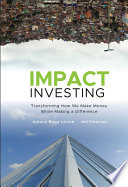

Impact investing is defined as investments made with the intention to generate positive, measurable social and environmental impact alongside a financial return. This concept challenges the traditional notion of investing, which typically prioritizes financial gain over social responsibility. Impact investing spans various asset classes, including private equity, venture capital, and fixed income. It emphasizes the importance of intentionality and measurement, ensuring that investors not only seek profit but also contribute to societal good. The book elaborates on how impact investing can address pressing global challenges such as poverty, climate change, and inequality, thereby aligning financial goals with the broader mission of creating a sustainable future.
Continue readingThe spectrum of impact illustrates the range of investment options available to those interested in impact investing. It categorizes investments from traditional philanthropy, which provides no financial return, to pure financial investments with no social or environmental considerations. Between these extremes lies a variety of strategies, including socially responsible investing (SRI), which screens out harmful industries, and impact-first investing, which prioritizes social impact over financial returns. Understanding this spectrum helps investors identify where their values align with their investment strategies, enabling them to make informed decisions that reflect their commitment to social change.
Continue readingMeasuring impact is a critical component of impact investing. The book discusses various frameworks and methodologies, such as the Global Impact Investing Network (GIIN) and the Impact Management Project (IMP), that provide tools for assessing the social and environmental outcomes of investments. The importance of metrics cannot be overstated, as they allow investors to evaluate the effectiveness of their investments and make necessary adjustments. The book emphasizes that impact measurement should be rigorous, transparent, and comparable, enabling stakeholders to assess the true value of impact investments and ensuring accountability in the sector.
Continue readingTechnology plays a pivotal role in the growth and effectiveness of impact investing. The book explores how advancements in technology facilitate better data collection, analysis, and reporting, which are crucial for measuring impact. Additionally, technology enables innovative financing mechanisms, such as crowdfunding and blockchain, that democratize access to capital for social enterprises. By leveraging technology, impact investors can enhance transparency, reduce transaction costs, and foster collaboration across sectors. The book illustrates several case studies where technology has been instrumental in scaling impact investments and reaching underserved communities.
Continue readingDespite its potential, impact investing faces several challenges and barriers that hinder its growth. The book outlines issues such as the lack of standardized metrics for measuring impact, the perception that impact investing sacrifices financial returns, and the limited availability of investment-ready social enterprises. Additionally, regulatory frameworks and market infrastructure can pose challenges for investors. The authors argue that addressing these barriers requires collaboration among stakeholders, including investors, policymakers, and social entrepreneurs, to create an ecosystem that supports impact investing and encourages more capital to flow into the sector.
Continue readingThe future of impact investing looks promising, with an increasing number of investors recognizing the importance of aligning their portfolios with their values. The book discusses trends such as the rise of millennial investors, who prioritize social and environmental considerations in their investment decisions, and the growing interest from institutional investors in integrating ESG (Environmental, Social, and Governance) factors into their strategies. Furthermore, the authors highlight the potential for impact investing to drive systemic change by influencing corporate behavior and public policy. The future of impact investing is characterized by innovation, collaboration, and a commitment to building a more equitable and sustainable world.
Continue readingThe book concludes with a powerful call to action for investors, entrepreneurs, and policymakers to embrace impact investing as a viable and necessary approach to addressing global challenges. It encourages readers to think critically about their investment choices and consider the long-term implications of their financial decisions. By adopting an impact investing mindset, individuals and institutions can contribute to a more sustainable future while also achieving financial success. The authors stress that collective action is essential in creating a robust impact investing ecosystem that can effectively address pressing social and environmental issues.
Continue reading